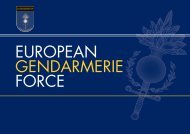Conference
science-research-bulletin-2013-conference
science-research-bulletin-2013-conference
You also want an ePaper? Increase the reach of your titles
YUMPU automatically turns print PDFs into web optimized ePapers that Google loves.
EUROPEAN POLICE SCIENCE AND RESEARCH BULLETIN<br />
SPECIAL CONFERENCE EDITION<br />
legislative powers on the states. This has similar<br />
effects, in practice, as EU Member States’ national<br />
sovereignty. By cooperating with other states<br />
and territories, for example, by exchanging<br />
information or allowing foreign police on one’s<br />
territory, state sovereignty in relation to national<br />
jurisdiction and law enforcement is endangered.<br />
Only Australian states have sovereignty under<br />
Chapter V, s 108 of the Australian Constitution,<br />
while the two territories (Northern Territory and<br />
Australian Capital Territory) are more dependent<br />
on the federal state. However, the territories also<br />
have their separate jurisdiction, police and criminal<br />
legislation. This constitutional framework led to<br />
the need for states and territories to either trade<br />
powers on a bilateral and multilateral basis or give<br />
up competences to the federal government to<br />
enhance cross-border police cooperation.<br />
Like EU Member States, Australian states and<br />
territories can enter into bilateral and multilateral<br />
relationships amongst themselves. On this basis,<br />
Australian states and territories have developed<br />
a number of initiatives to counter cross-border<br />
crime, mostly in the form of Memoranda of<br />
Understanding (MOUs), with other domestic<br />
jurisdictions. A recent multilateral cross-border<br />
initiative, called Ngaanyatjarra Pitjantjatjara<br />
Yankunytjatjara lands (NPY lands) cooperation,<br />
between the Northern Territory (NT), Western<br />
Australia (WA) and South Australia (SA), for<br />
example, led to the ceding of competences<br />
between a territory and two states (Standing<br />
Committee on Legal and Constitutional Affairs,<br />
2009, Chapter 2).<br />
The most prominent agencies in the areas of<br />
multijurisdictional policing and information<br />
exchange are the Australian Federal Police<br />
(AFP) and CrimTrac, an agency created under a<br />
multilateral MOU between all states and territories<br />
and the Commonwealth to facilitate information<br />
sharing (CrimTrac, 2009). Another initiative to<br />
harmonise cross-border policing standards and<br />
practices in Australia is the creation of model<br />
legislation (Standing Committee of Attorney<br />
General and Australasian Police Ministers Council<br />
Joint Working Group on National Investigations,<br />
2003, i), though this is, similar to EU framework<br />
decisions and conventions, rarely implemented<br />
uniformly by states and territories. Despite<br />
Australia being a Federation, a uniform legal<br />
framework for police cooperation does not exist.<br />
This causes problems for police cooperation<br />
comparable to the ‘patchwork’ system in the EU.<br />
Despite the similarities of the EU and Australia<br />
at the legislative level, the comparability at the<br />
executive level is more unbalanced. Both objects<br />
of the comparison differ considerably in relation<br />
to their population size and degree of historical,<br />
cultural and organisational diversity. Australia’s<br />
population size is about 23.4 million (Australian<br />
Bureau of Statistics, 2014). This compares to<br />
503 million inhabitants of the EU (Europa,<br />
2014). Australia covers a total area of 7,692,024<br />
sq kilometres (including islands) (Australian<br />
Government, 2009). This compares to the EU<br />
area, which covers about 4,300,000 sq kilometres<br />
(Europa, 2009). All police forces in Australian states<br />
and territories have developed according to the<br />
British model, and at about the same time, with<br />
some necessary adaptation to the colonial context<br />
(Finnane, 1994, pp. 14-23). The differences in<br />
history, structure and culture of Australian police<br />
forces are therefore much more subtle than those<br />
in EU countries. Policing structures in the EU differ<br />
significantly from Member State to Member<br />
State according to the particular state structure<br />
(whether centralised or decentralised), historical<br />
events (e.g. wars) and legal cultures (e.g. common<br />
law or civil law) (Fijnaut, 1994, pp. 600-603).<br />
However, both systems are today promoting<br />
‘compensatory’ strategies, such as common<br />
education and training of police across different<br />
jurisdictions (Lafferty & Fleming, 2000; Pagon,<br />
1996; and in relation to CEPOL, Occhipinti, 2003,<br />
pp. 126-129). This shows that similarities exist<br />
even at the executive level.<br />
IV. EU SIMILARITIES WITH THE<br />
FEDERAL AUSTRALIAN SYSTEM<br />
The existence of common ‘compensatory’<br />
strategies in both systems indicates that police<br />
organisations share many sociological similarities<br />
with regards to police cooperation. A major<br />
difference and advantage of EU cooperation<br />
compared to Australian strategies is the existence<br />
of harmonised legal frameworks, such as the<br />
Schengen Convention and the 2000 Mutual<br />
Legal Assistance Convention, governing police<br />
cooperation in the EU. They could hence be a<br />
model that has the potential to improve police<br />
cooperation in Australia (as confirmed by the<br />
recent calls for legal frameworks by Australian<br />
practitioners).<br />
118





